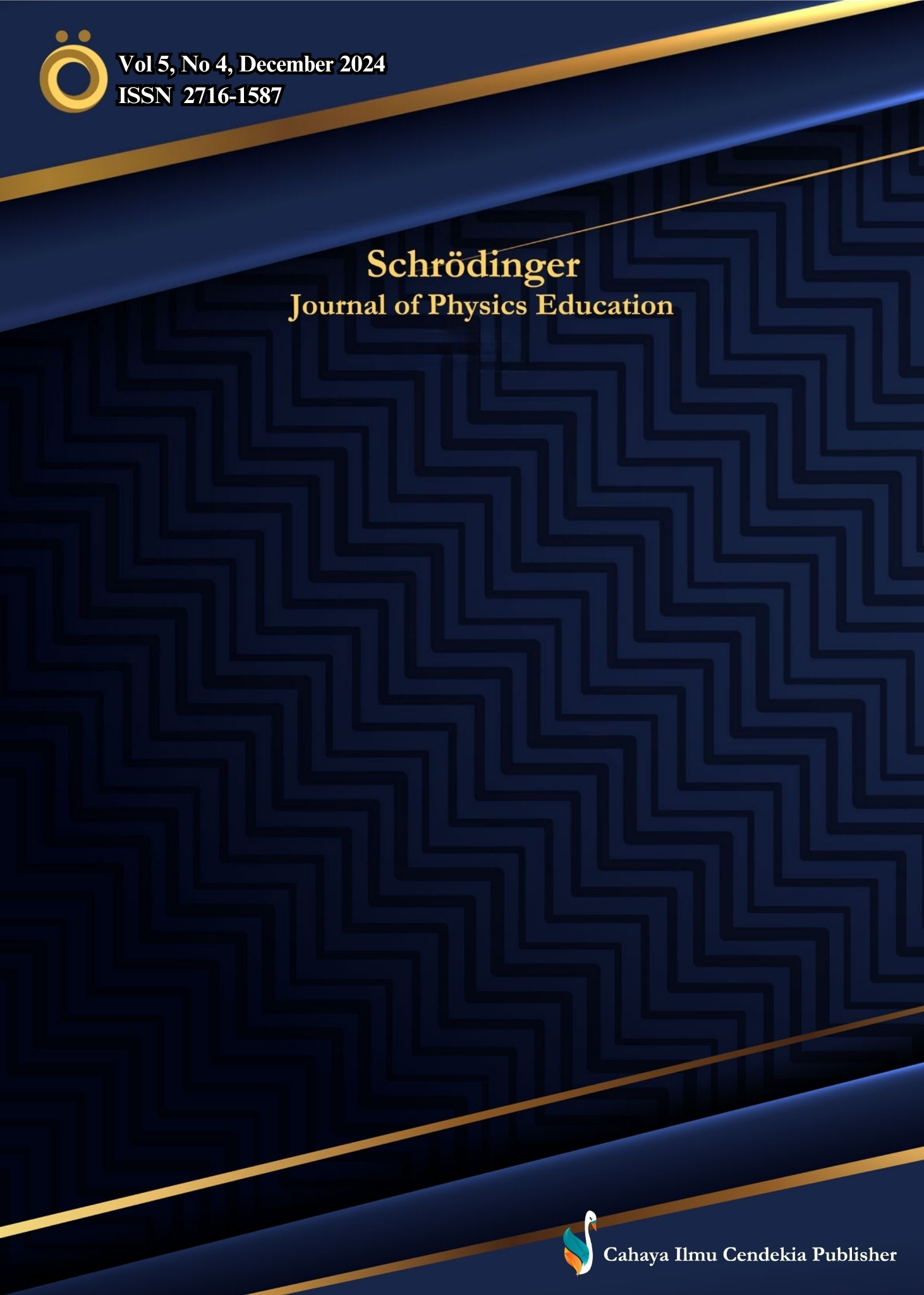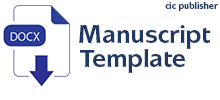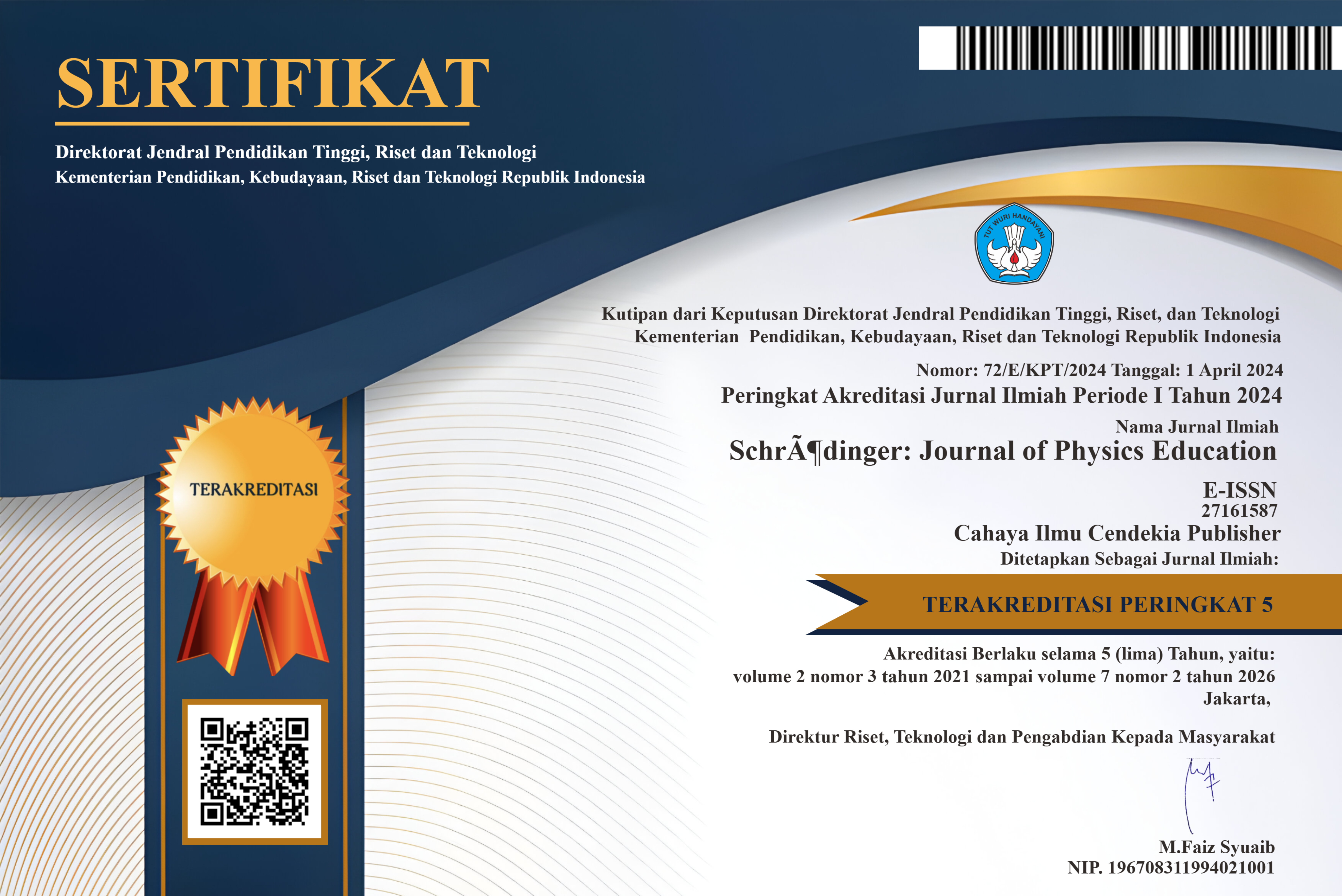The Influence of Using Edmodo Media with the Discovery Learning Learning Model on Science Learning Outcomes on Pressure in Substances
Abstract
Purpose of the study: The purpose of this study was to determine the effect of Edmodo media with the discovery learning model on science learning outcomes on the material on pressure in substances.
Methodology: This type of research is quasi-experimental quantitative. Sampling in this study was carried out by purposive sampling, namely class VIII D (experimental class) and class VIII E (control class) of junior high school, with 30 students and 28 students respectively. Data collection techniques use questions, questionnaires, observation sheets and documentation. This research instrument includes questions, questionnaires and observation sheets. Hypothesis testing is carried out using correlation coefficients and simple linear regression.
Main Findings: There is an influence of 20.5% between two variables on the results of the simple linear regression test with a significance value of 0.015. So it can be concluded that there is an influence of Edmodo media with the Discovery Learning learning model on science learning outcomes regarding pressure in substances.
Novelty/Originality of this study: The results of this study can be a basis for the development of Edmodo learning media or the further application of Edmodo media. In addition, it also becomes an added value to the scientific knowledge in the field of education in Indonesia.
References
O. Dakhi, J. Jama, D. Irfan, Ambiyar, and Ishak, “Blended Learning: a 21St Century Learning Model At College,” Internatinal J. Multiscience, vol. 1, no. 7, pp. 50–65, 2020.
L. Zhang, M. Xu, H. Chen, Y. Li, and S. Chen, “Globalization, Green Economy and Environmental Challenges: State of the Art Review for Practical Implications,” Front. Environ. Sci., vol. 10, no. March, pp. 1–9, 2022, doi: 10.3389/fenvs.2022.870271.
A. Mason and R. Lee, “Six Ways Population Change Will Affect the Global Economy,” Popul. Dev. Rev., vol. 48, no. 1, pp. 51–73, 2022, doi: 10.1111/padr.12469.
L. Li, “Reskilling and Upskilling the Future-ready Workforce for Industry 4.0 and Beyond,” Inf. Syst. Front., vol. 26, no. 5, pp. 1697–1712, 2022, doi: 10.1007/s10796-022-10308-y.
D. Vargo, L. Zhu, B. Benwell, and Z. Yan, “Digital technology use during COVID-19 pandemic: A rapid review,” Hum. Behav. Emerg. Technol., vol. 3, no. 1, pp. 13–24, 2021, doi: 10.1002/hbe2.242.
W. M. Al-Rahmi, A. I. Alzahrani, N. Yahaya, N. Alalwan, and Y. Bin Kamin, “Digital communication: Information and communication technology (ICT) usage for education sustainability,” Sustain., vol. 12, no. 12, pp. 1–18, 2020, doi: 10.3390/su12125052.
M. Liesa-Orús, C. Latorre-Cosculluela, S. Vázquez-Toledo, and V. Sierra-Sánchez, “The technological challenge facing higher education professors: Perceptions of ICT tools for developing 21st Century skills [El Desafío Tecnológico que Enfrentan los Profesores de Educación Superior: Percepciones sobre las Herramientas de TIC para Desarro,” Sustainability, vol. 12, no. 5339, pp. 1–14, 2020, [Online]. Available: https://doi.org/10.3390/su12135339
L. Yurui, Z. Xuanchang, C. Zhi, L. Zhengjia, L. Zhi, and L. Yansui, “Towards the progress of ecological restoration and economic development in China’s Loess Plateau and strategy for more sustainable development,” Sci. Total Environ., vol. 756, p. 143676, 2021, doi: 10.1016/j.scitotenv.2020.143676.
J. Portillo, U. Garay, E. Tejada, and N. Bilbao, “Self-perception of the digital competence of educators during the covid-19 pandemic: A cross-analysis of different educational stages,” Sustain., vol. 12, no. 23, pp. 1–13, 2020, doi: 10.3390/su122310128.
A. M. Maatuk, E. K. Elberkawi, S. Aljawarneh, H. Rashaideh, and H. Alharbi, “The COVID-19 pandemic and E-learning: challenges and opportunities from the perspective of students and instructors,” J. Comput. High. Educ., vol. 34, no. 1, pp. 21–38, 2022, doi: 10.1007/s12528-021-09274-2.
C. Coman, L. G. Țîru, L. Meseșan-Schmitz, C. Stanciu, and M. C. Bularca, “Online teaching and learning in higher education during the coronavirus pandemic: Students’ perspective,” Sustain., vol. 12, no. 24, pp. 1–22, 2020, doi: 10.3390/su122410367.
M. D. Abdulrahaman et al., “Multimedia tools in the teaching and learning processes: A systematic review,” Heliyon, vol. 6, no. 11, p. e05312, 2020, doi: 10.1016/j.heliyon.2020.e05312.
C. W. Hoerudin, S. Syafruddin, A. Mayasari, O. Arifudin, and S. Lestari, “E-Learning as A Learning Media Innovation Islamic Education,” QALAMUNA J. Pendidikan, Sos. dan Agama, vol. 15, no. 1, pp. 723–734, 2023, doi: 10.37680/qalamuna.v15i1.4466.
A. Prabawati, S. A. AM, and S. A. AM, “the Students ’ Perception of the Online Media Used By,” English Lang. Teach. Methodol., vol. 1, no. 3, pp. 169–181, 2021.
R. Roro et al., “E-Learning as Education Media Innovation inthe Industrial Revolution and Education 4.0 Era.,” J. Contemp. Issues Bus. Gov., vol. 27, no. 1, pp. 2868–2880, 2021, [Online]. Available: https://cibgp.com/article_9498.html
J. Gómez-Galán, “Media education in the ICT Era: Theoretical structure for innovative teaching styles,” Inf., vol. 11, no. 5, pp. 1–17, 2020, doi: 10.3390/INFO11050276.
W. Wibowo and N. Astriawati, “The effectiveness of using Edmodo based e-learning in the applied mechanics course,” J. Phys. Conf. Ser., vol. 1511, no. 1, pp. 0–7, 2020, doi: 10.1088/1742-6596/1511/1/012121.
F. Nami, “Edmodo in semi-technical English courses: towards a more practical strategy for language learning/practice,” Comput. Assist. Lang. Learn., vol. 35, no. 7, pp. 1533–1556, 2022, doi: 10.1080/09588221.2020.1819340.
C. W. M. Malinao and M. M. Sotto, “Home quarantined: Privacy at risk in technologically-oriented learning amidst COVID-19 pandemic,” Int. J. Eval. Res. Educ., vol. 11, no. 1, pp. 224–238, 2022, doi: 10.11591/ijere.v11i1.22059.
C. Greenhow and S. Galvin, “Teaching with social media: evidence-based strategies for making remote higher education less remote,” Inf. Learn. Sci., vol. 121, no. 7–8, pp. 513–524, 2020, doi: 10.1108/ILS-04-2020-0138.
A. Kumi-Yeboah, Y. Kim, A. M. Sallar, and L. K. Kiramba, “Exploring the use of digital technologies from the perspective of diverse learners in online learning environments,” Online Learn. J., vol. 24, no. 4, pp. 42–63, 2020, doi: 10.24059/olj.v24i4.2323.
F. Altinay, Ö. Beyatli, G. Dagli, and Z. Altinay, “The role of Edmodo model for professional development: The uses of blockchain in school management,” Int. J. Emerg. Technol. Learn., vol. 15, no. 12, pp. 256–270, 2020, doi: 10.3991/ijet.v15i12.13571.
U. Usman, T. Muhammad, and B. E. Yanto, “How to Apply Android Applications (Edmodo) and Google Forms as Learning Media in Historical Learning in High School,” AL-ISHLAH J. Pendidik., vol. 14, no. 4, pp. 5477–5482, 2022, doi: 10.35445/alishlah.v14i4.1882.
L. R. Choirunnisya’ and P. Sudira, “Developing an e-module of making Edmodo-based Hosanna Moda system bustier to improve learning independence and learning achievement,” J. Pendidik. Vokasi, vol. 11, no. 3, pp. 275–293, 2021, doi: 10.21831/jpv.v11i3.44094.
M. Thoiyibi and M. Nuzli, “Using Edmodo as a Media of E-Learning Learning in Educational Technology Courses,” Sink. J. dan Penelit. Tek. Inform., vol. 6, no. 2, pp. 478–484, 2022, doi: 10.33395/sinkron.v7i2.11349.
P. O. Lestari, “Learning Development Model Discovery Learning Motivation To Improve Education Student Writing Indonesian FKIP UMSU,” … Int. Conf. …, vol. 9, no. January, pp. 235–244, 2022, [Online]. Available: https://books.google.com/books?hl=en&lr=&id=MmNiEAAAQBAJ&oi=fnd&pg=PA235&dq=student+motivation&ots=WphpFWF_nE&sig=wByrBlHK4Kp6Kp-Q8udg66K8Cbw
K. H. Inde, M. B. U. Kaleka, and I. Ilyas, “the Effect of Discovery Learning Model on Learning Outcome of Grade-Vii Students of Smpn 5 Nangapanda,” J. Sci. Educ. Res., vol. 4, no. 1, pp. 11–14, 2020, doi: 10.21831/jser.v4i1.34233.
T. Nasution, D. Afrianti, T. Tukiyo, S. Sulistyani, and H. Herman, “Critical Discourse Analysis in the Classroom: A Critical Language Awareness on Early Children’s Critical Thinking,” J. Obs. J. Pendidik. Anak Usia Dini, vol. 6, no. 5, pp. 4992–5002, 2022, doi: 10.31004/obsesi.v6i5.2951.
H. Zulnaidi, S. Heleni, and M. Syafri, “Effects of SSCS Teaching Model on Students’ Mathematical Problem-Solving Ability and Self-Efficacy.,” Int. J. Instr., vol. 14, no. 1, pp. 475–488, 2021.
R. Purnamasari et al., “Student center based class management assistance through the implementation of digital learning models and media,” J. Community Engagem., vol. 02, no. 02, pp. 41–44, 2020, [Online]. Available: https://journal.unpak.ac.id/index.php/jce
M. P. Simanjuntak, E. I. Sihite, and R. D. Suyanti, “The Effect of Blended Learning with Edmodo-Assisted Scientific Approach on Independence and Science Learning Outcomes,” Int. J. Instr., vol. 16, no. 4, pp. 135–154, 2023, doi: 10.2991/978-94-6463-158-6_25.
G. Kotronoulas and C. Papadopoulou, “A Primer to Experimental and Nonexperimental Quantitative Research: The Example Case of Tobacco-Related Mouth Cancer,” Semin. Oncol. Nurs., vol. 39, no. 2, pp. 0–6, 2023, doi: 10.1016/j.soncn.2023.151396.
P. Castelnovo, S. Clò, and M. Florio, “A quasi-experimental design to assess the innovative impact of public procurement: An application to the Italian space industry,” Technovation, vol. 121, no. December 2022, 2023, doi: 10.1016/j.technovation.2022.102683.
Copyright (c) 2024 Siti Jumaeroh, Deepak Raj Chetri, Hogantharanni Govender

This work is licensed under a Creative Commons Attribution 4.0 International License.
Authors who publish with this journal agree to the following terms:
- Authors retain copyright and acknowledge that the Schrödinger: Journal of Physics Education is the first publisher licensed under a Creative Commons Attribution 4.0 International License.
- Authors are able to enter into separate, additional contractual arrangements for the non-exclusive distribution of the journal's published version of the work (e.g., post it to an institutional repository or publish it in a book), with an acknowledgment of its initial publication in this journal.
- Authors are permitted and encouraged to post their work online (e.g., in institutional repositories or on their website) prior to and during the submission process, as it can lead to productive exchanges and earlier and greater citation of published work.







.png)
.png)








.png)
.png)
.png)







